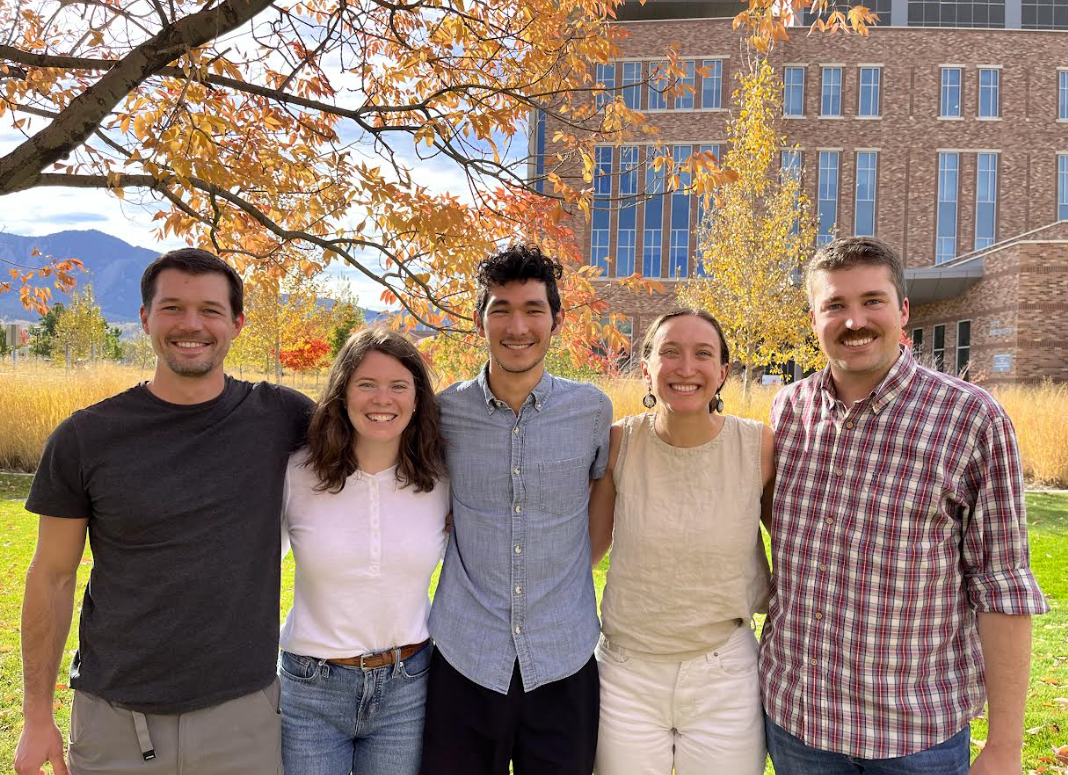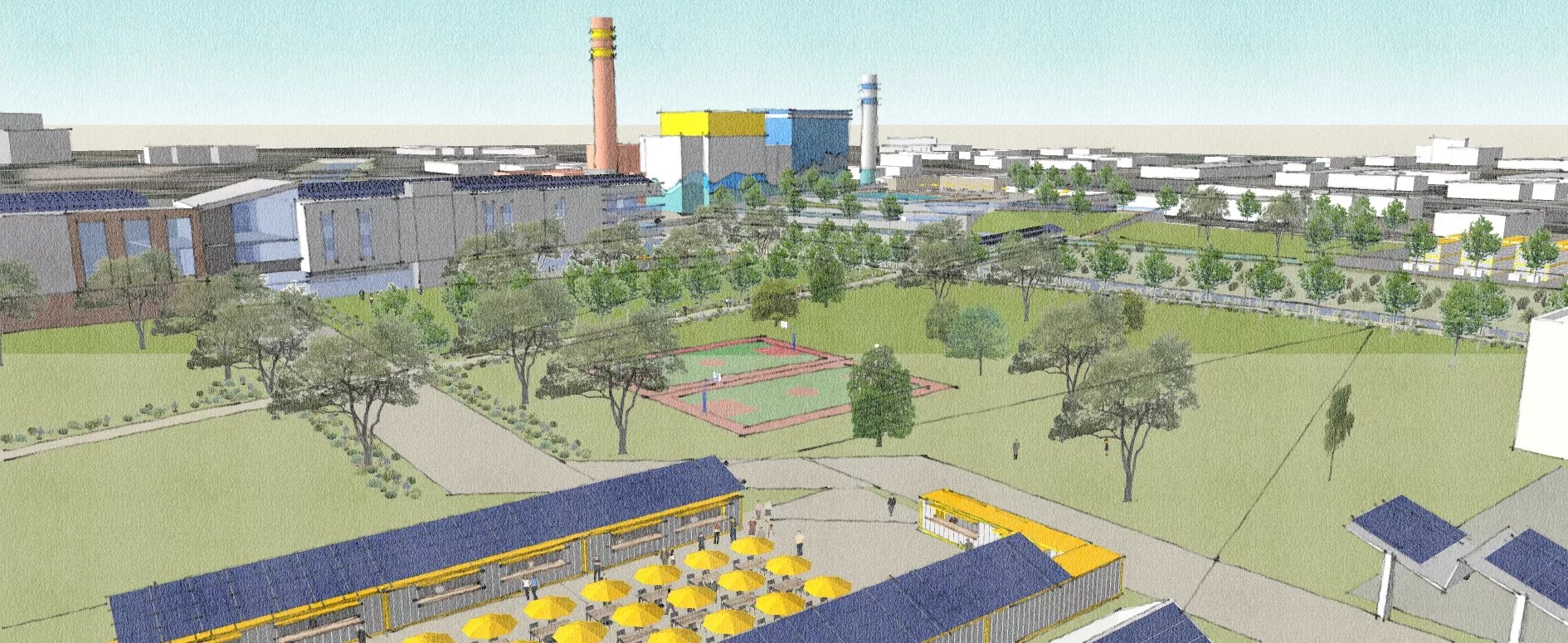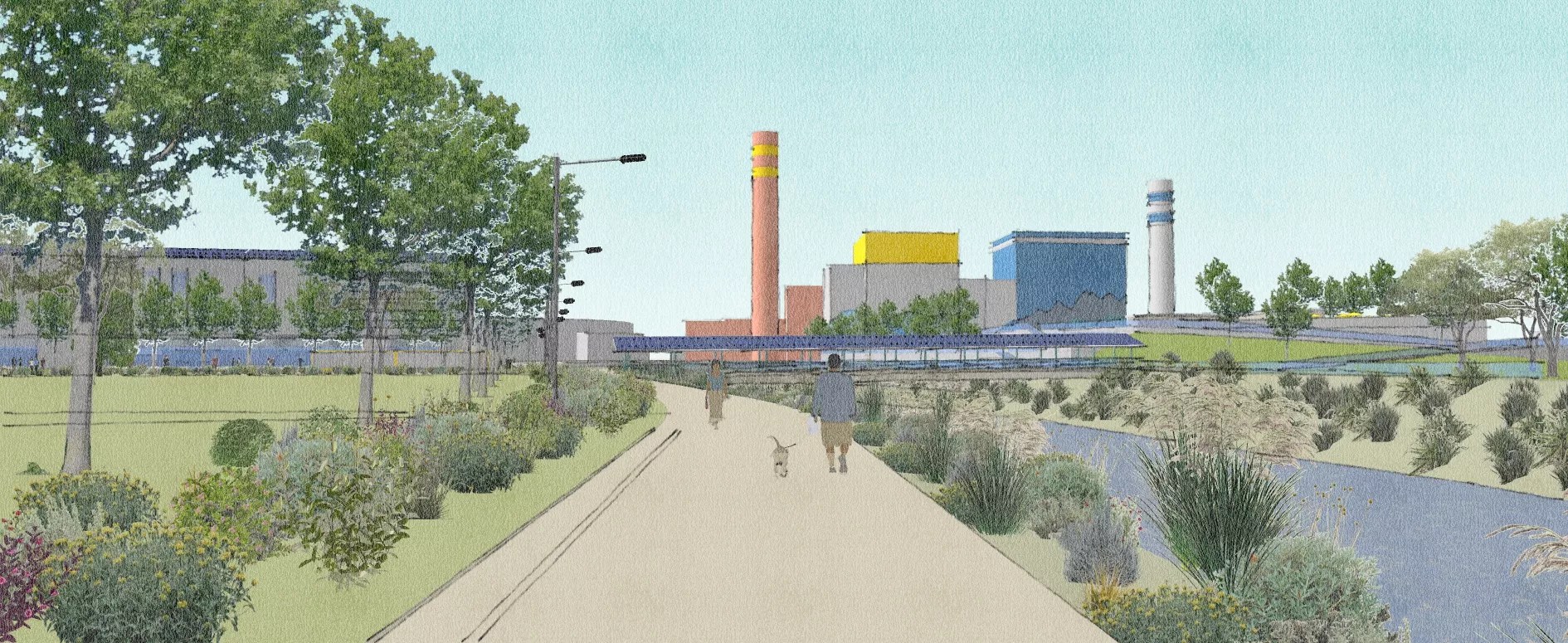
Courtesy AES Corporation

Audio By Carbonatix
Graduate students from the University of Colorado Boulder took home the top prize in a national competition hosted by AES Corporation, the utility and power giant, for their proposal to revitalize Xcel Energy’s controversial Zuni Generating Station in Denver’s Sun Valley neighborhood.
The team – known as the Green Grad Buffs and made up of Masters of the Environment (MENV) students Thomas Hill, Tatiana Huet de Bacellar, Patrick Fegan, Emily Cummins and Andrew Bayliss – won first place in the AES Energy Innovation Challenge after designing a way to power the former coal and steam plant’s underground heating network with solar and wind power, while also adding lithium ion and thermal battery storage.
“[A thermal battery] takes the heat from the sun and can hold on to it for much longer than a lithium ion battery because it’s not a chemical reaction happening,” Cummins tells Westword. “It’s just sand holding onto heat.”
That heat can last for months, Cummins says, so it could be deployed in the winter after charging up during hot Denver summers. Under the Green Grad Buffs’ plan, stored electricity could be pushed through the underground network to heat homes in the nearby Sun Valley and La Alma Lincoln Park neighborhoods in order to decrease their reliance on natural gas for warmth.
Denver, make your New Year’s Resolution Count!
We’re $17,500 away from our End-of-Year campaign goal, with just a five days left! We’re ready to deliver — but we need the resources to do it right. If Westword matters to you, please contribute today to help us expand our current events coverage when it’s needed most.
“We each brought something really fun and it was a very different experience than our classwork, because it was a blank slate,” Huet de Bacellar says. “Our creative juices got to really flow. At the beginning, we were just throwing out these wild ideas of, ‘What if we could…insert crazy assumption of something that maybe wouldn’t actually be feasible,’ and then bringing it back down.”
Regardless of where their research took them, the CU students always returned to the goal of bringing benefits to the community. That north star helped ground them and resulted in their final idea, which would also include the creation of a local energy museum and community center with a workforce training program on-site at the steam plant.
“Part of that community used to be a former EPA Brownfield site, so we saw an opportunity to give them a purpose-built community center and supplement the existing community that was there,” Fegan says.

The team’s idea would situation solar panels on top of food stalls to generate electricity for the neighborhood.
Courtesy AES Corporation
The hundred-plus-year-old historic power plant, which sits on a seven-acre plot of land owned by Xcel Energy on the east bank of the South Platte River at West 13th Avenue, was retired in 2015. In January 2021, the Colorado Public Utilities Commission approved a plan to decommission the plant and conduct environmental remediation at the site. That plan would eventually result in the building’s destruction.
When the community heard about the plan, they weren’t happy: They’d hoped the building could be used to promote access to food in the area. Thanks to attention from Denver City Council and Historic Denver, Xcel promised in July 2022 to wait a year to demolish it.
Now, with that moratorium over, residents are again worried about what could happen to the property.
A coalition of thirty community groups, headed by Historic Denver, sent a letter to Mayor Mike Johnston and Denver City Council on November 9, asking them to ensure that the building can’t be destroyed and to identify a developer that would repurpose it for community use.
“We are seeking to work cooperatively with the City and County of Denver and Xcel Energy to encourage the reuse of this historic property in a manner that is transparent and that springboards a dynamic partnership to create an exciting and community-focused future for this important piece of Denver’s built history,” the letter says.
Historic Denver CEO John Deffenbaugh tells Westword the expiration of the moratorium prompted the renewed call for city support, because the community is concerned that demolition could take place. Historic Denver wrote a letter last October to then-Mayor Michael Hancock, noting that the building is likely eligible for landmark designation and a good candidate for adaptive reuse; it also offered to help Xcel examine the possibilities.
“There’s a number of different parties involved in the future of the steam plant, and we just want everyone to talk to each other and open communication channels and connect decision makers with community,” Deffenbaugh says. “Historic Denver’s role has been to act as a convener and a hub.”
Deffenbaugh notes that there are examples all over the world of large, industrial structures being transformed into community hubs and retaining their history. For example, at Beloit College in Wisconsin, an old steam plant was adapted into a student union; the Tate Modern museum in London was once a power station.
“Buildings tell the stories of their communities and buildings are a built representation of our past,” Deffenbaugh says. “It’s part of the growth of Denver. The presence of this building and the energy that was created inside it enabled the growth of west Denver.”
Along with being a rare “anchor building” with unusual scale and architectural quality, according to Deffenbaugh, the Zuni Steam Plant represents a chance for environmental justice: While it once provided energy, it also contributed to polluting some of Denver’s most historically disadvantaged neighborhoods.
“There’s a wonderful opportunity to flip the script and turn this building into a place the community can benefit from,” Deffenbaugh says. “Most importantly, it should stay because the people in the community want it to stay. …We can take this building that polluted the local community into something that serves it.”
Through a spokesperson, Xcel tells Westword it is continuing conversations with the city and is interested in exploring possible reuse ideas of the plant for “overall community benefit.”

The proposal preserves the original steam plant while adding community uses to the site and surrounding area.
Courtesy AES Corporation
Community inclusion was a major factor in the Green Grad Buffs’ research, since it was part of the prompt from AES for the competition. “Especially in energy, there’s a history of certain communities being left behind or being forced to bear the whole burden of energy infrastructure,” Bayliss says. “The clean energy transition presents a really good opportunity to not make those mistakes again, so that community involvement piece was something that really jumped out at us.”
Before entering the challenge, Cummins had read news reports about the community’s desire to retain the building and possibly use it as a food hall. Their master’s program had also brought the students to Sun Valley to see an example of sustainable building development as it undergoes a major redevelopment through the Denver Housing Authority.
It made sense for the team to design something they were personally connected to, Cummins says.
Once everyone realized how much space solar arrays can take up, they began to look into battery storage – with the hope of needing fewer panels, should they be able to spread out the energy being collected over time. That’s how the team members landed at their final solution.
Madelka McCalla, chief corporate affairs and impact officer with AES, says the Energy Innovation Challenge is designed to inspire real-world solutions, which is why it placed an emphasis on community in the competition’s third year.
“One of the things that we’ve learned – sometimes the hard way – is that community needs to be involved since the beginning,” she says. “There is no technical solution, at least in our view, that could be implemented without a robust environmental and social solution that communities feel are adding value to their ecosystem.”
Deffenbaugh tells Westword that he thinks it’s great these students wanted to create a solution for the community. “It’s so exciting, especially when students are involved because the vision that students can generate can be the spark for a real-world solution,” he says. The CU team wanted to do this while also preserving as much of the plant’s existing infrastructure as possible in an effort to cut down on costs.
While the competition is completely hypothetical – students didn’t have exact measurements or other information they would need to formulate an official proposal – they did their best to make their renderings as realistic as they could.
Xcel says it would like to host the team on a tour of the plant, if they members are interested.
“Congratulations to the University of Colorado Boulder students for winning the AES 2023 Energy Innovation Challenge,” the energy company says through a spokesperson. “We’re fascinated by the team’s innovative ideas to adapt existing infrastructure with new technologies while being mindful of community impact – the very solutions needed to solve today’s energy challenges.”
The students won a $10,000 prize and $1,000 donation to the charity of their choice, which they directed to the Sun Valley Kitchen & Community Center, a nonprofit that serves as a community food hub in the neighborhood. Cummins says that during their research, they continually came across residents calling for better food access in the area.
“We picked an organization that seemed to be doing that and seemed to be really active in this community,” she says. “We didn’t want to donate to a random, unconnected charity.”
As for the $10K they won for themselves, almost all of the students are dedicating their cuts to life expenses – car and computer repairs, student loan payments and winter tires.
“It was a really fun experience,” Hill says. “We learned a lot. It was a fast-paced, quick turnaround. We got to really bond as a team.”